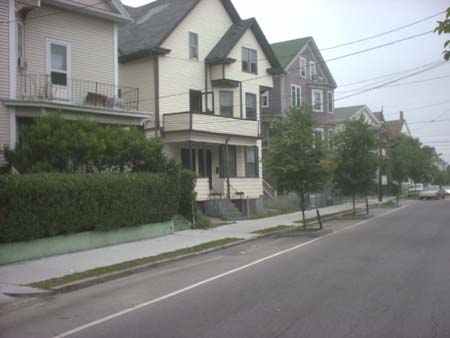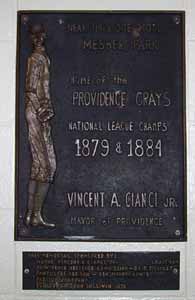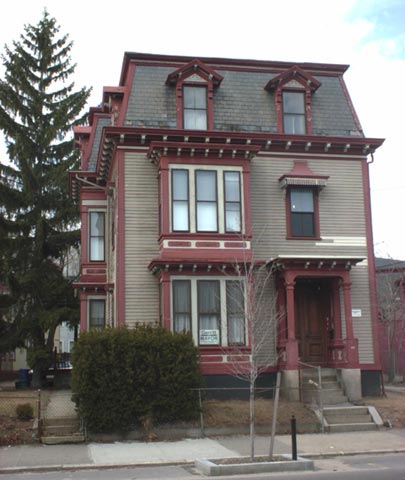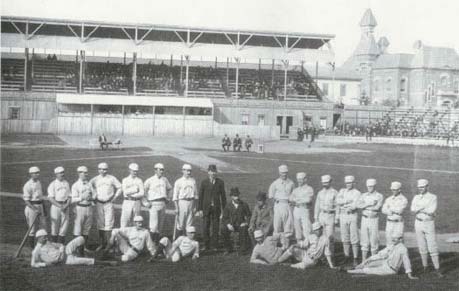

|
Messer Park | |||||||
|
Providence, RI
| Team: Providence Grays | Major League Dates: May 1, 1878 - September 9, 1885 |
| Dimensions: LF 281 LF Corner 403 LCF 356 CF 318 RCF 356 RF 431 |
Memorable Moments:
 |
 |
In 1878 the Providence Base Ball Association was formed and they went looking for a site where they could play ball. After looking at various plots around the city, they came to the "West Training Ground Plat."
A quick history lesson. In 1856 a wealthy cotton merchant, Josiah Chapin (1788 - 1881) purchased a large expanse of land from R.M. and C.B. Snow. This land was located in the village of Olneyville near the Cranston Street Armory and Dexter Training Ground, just a few miles west of downtown Providence. When the old man went a bit dingy, he had some trustees appointed to handle his legal affairs. They sectioned off parts of the land into housing plots and called it the "West Training Ground Plat." Most of the lots didn't sell. One of the Messer Street lots was purchased by Stephen Tourtellot who built a house that still stands at 107 Messer St. (see below). Many of the houses today in that are look like Tourtellot's.
 |
 |
The Union Railroad company had cars that ran on High Street (now Westminster) and on game days they would put in a spur that would bring people directly to the gate. There were also cars on Cranston and Broadway, which is in easy walking distance, so this seemed like the logical place to build a park.
This was the first park that had a screen behind home plate to protect fans from foul balls. They also hosted the first National League Championship game in 1884 which the Grays won.

The Grays were folded in 1885 clearing the way for the Philadelphia Phillies. This was done so the National League could have teams in larger cities than the likes of Indianapolis, Troy, and Providence. In 1886, Messer Street Grounds housed the Eastern Minor League Providence Grays, but attendance was terrible. On February 17, 1887, Chapin Trustee Edward Abon Greene sold the land containing the park to the Franklin Institute for Savings who demolished the park and sold the land off as housing plots.
Here is an excerpt from the May 2, 1878 Providence Morning Star about opening day:
"The large grandstand held twelve hundred people, among them hundreds of ladies. The long semi-circular tiers of seats were black with men and boys, and hundreds were standing, unable to get seats. The commodious space for carriages was completely filled, and one or two May Day riding parties also graced that part of the grounds... Two registering turnstiles gates admit the patrons to the grounds, and as each ticket holder passes through the gate he steps on a raised platform, and by a mechanical arrangement is registered, and only one person can pass through the gate at a time. Near the gate are two ticket offices, and a large entrance through which the crowd can pass at the end of the game. At the southeast corner there is a large gate to admit carriages to the park. The ground, which contains nearly six acres of land, is enclosed by a fence twelve feet high. The diamond is as level as constant rolling by heavy stone and iron rollers can make it. Inside of the base lines is turfed, except a space nine feet in width, reaching from the pitcher's position to the home plate. Twenty-two feet are sodded outside of the diamond. Paths leading to and from the bases have been rolled hard, and the out-field is sown with grass seed. The grand stand which will seat nearly 1200 people, is 151 x 40 feet, and in the rear is raised 34 feet. The stand is reached by steps at both ends. It will be covered by canvass, requiring nearly 7,000 feet. Seats are arranged in a circle at the eastern and western sides of the field. A platform zzz x zzzz feet has been erected for the reporters, scorers and invited guests, seating nearly 80 persons. Under the grand stand for the visiting and local clubs are rooms 20 feet square and fitted up with wardrobes, dressing rooms 20 feet square, a wash room supplied with Pawtucket water, closet, etc. The Western Union Telegraph Company have a room 8 x 10 feet. There is a stockholders' room 20 feet square, and a refreshment saloon 40 x zzzz to be managed by caterer Ardoene. A fence with gateways has been erected in front of the club rooms, thereby preventing the crowd from having any talk with the players. The grounds are without doubt as fine as any in the country, and Harry Wright said yesterday: 'They are beautiful.'"
© 2002-17 Paul Healey.